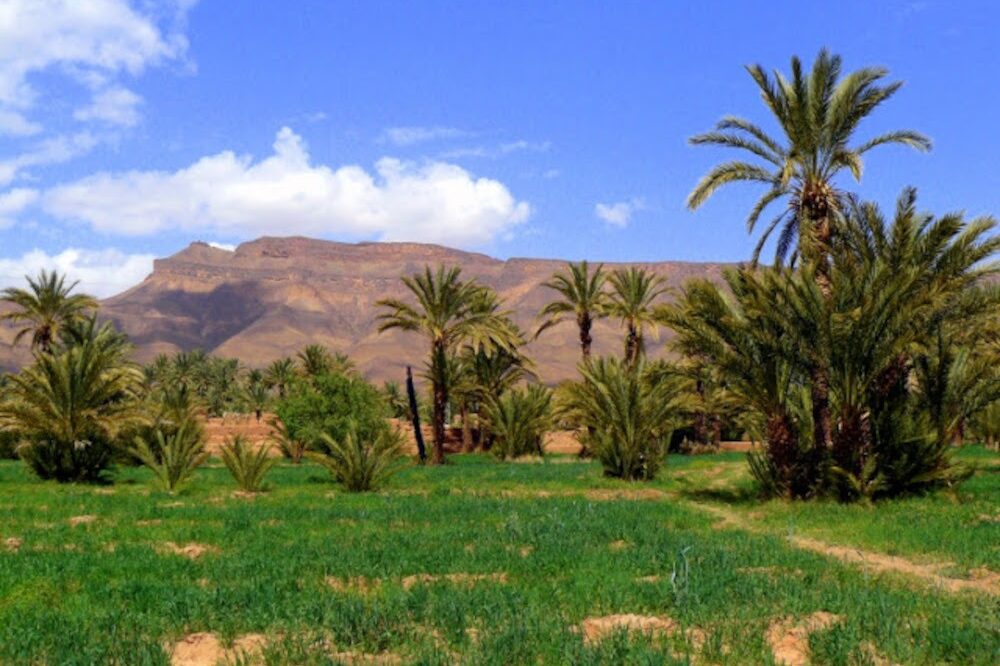THE DRAA VALLEY, THE LARGEST OASIS IN MOROCCO, IS TODAY UNDER A GROWING THREAT DUE TO THE COMBINED EFFECTS OF CLIMATE CHANGE AND HUMAN IMPACT
The Draa Valleythe largest Moroccan oasis, is today under increasing threat due to the combined effects of climate change and human impact. Accelerated urbanization and intensive agricultural expansion in the Middle Draa Valley (VMD) are depleting the water resources of this arid and fragile region.
With an extension of 15 thousand km² and a length of 200 km, the VMD depends entirely on the Draa River and the Mansour Eddahbi Dam for itswatermaking sustainable management of these resources vital for the survival of local communities and the environment.
The Draa, an intermittent river
The hot, arid climate and rare intense rainfall characterize the Draa Valley; the oases present here occupy approximately 26 thousand hectares of surface area. Thanks to the stratified vegetation, dominated by date palms, these oases create microclimates that allow crop diversification.
However, since the construction of the Mansour Eddahbi Dam in 1972, the Draa has become an intermittent river. In this situation, surface water resources are progressively reduced and groundwater withdrawal increases. This excessive exploitation, however, threatens underground reserves and increases the salinity of the water, making it progressively less suitable for agricultural use.
Furthermore, it reduces the dam’s capacity, which had already decreased by 25% in 1998 due to siltation, a problem common to other dams in the region.

Water-demanding crops intensify the water crisis
Water-demanding crops, such as watermelon, intensify the water crisis. From 2012 to 2014, the acreage devoted to this crop in the valley quadrupled, placing further pressure on available water. The area’s economic dependence on agriculture is evident: 96.66% of water resources are used in agriculture, compared to only 2.7% for domestic use.
Draa Valley at risk of irreversible environmental crisis
Experts warn that the combination of rapid urbanisation, population growth and unsustainable agricultural practices could lead to an irreversible environmental crisis in the Draa Valley. To ensure a future for the valley, a balance is needed between economic development and conservation of natural resources, protecting the environment and future generations.
The valley oasis, recognized as a biosphere reserve, today faces growing vulnerability due to climate change and anthropogenic impacts. According to the Environmental Vulnerability Index (EVI), three main indicators outline the severity of degradation: water scarcity, desertification and loss of biodiversity.
A research by Prof. Ahmed Karmaoui – teacher atMoulay Ismail University and president of Southern Center for Culture and Science in Morocco – and his collaborators in 2015 underlined theurgency of targeted interventions to reduce human impact and mitigate climate effects, safeguarding the ecological balance of the valley.
His studies include the analysis of supply-demand for water in arid environments such as the Draa Valley and the role of wetlands in ecological resiliencecentral issues in the context of the climate crisis.
Oasis ecosystems under pressure
Water availability is increasingly limited and subject to salinizationwhile more frequent and intense heat waves aggravate desertification and hinder cultivation. Human activities, such asintensive agriculture and tourism, exert unsustainable pressure on the oasis ecosystems, accelerating land degradation and reduction of biodiversity.
Draa Valley, Morocco: the consequences of climate change
Extreme climate events have recently exposed the valley’s vulnerability. As of September 6, 2024, exceptional rainfall has caused devastating floods. In twelve hours alone, over 50 mm of rain fell, causing the Draa river to overflow again, causing destruction and victims in the provinces of Tata, Zagora, Ouarzazate and others.
This catastrophic event underlined the precariousness of an area already afflicted by drought and climate variability. During the torrential rains between 19 and 21 September, the Draa traveled 650 km from Ouarzazate to Tan Tan, interrupted traffic in 44 road sections and caused dozens of victims.
In the heart of the desert, near the Erg Chegaga dune, in Mhamid el Ghizlan, Lake Iriqi showed a extraordinary event: After forty years of drying up, recent rains have rapidly filled it, temporarily transforming the landscape.
Satellite images of the constellation Sentinel-2 they, instead, documented the progressive desertification of a valley that was once lush. These data show a drastic decline in vegetation, the growth of arid lands and the decrease in water resources, signaling a worsening accelerated by human presence.
It is urgent to adopt sustainable interventions
Therefore, the images from the Sentinel-2/Copernicus satellite constitute a clear warning. They emphasize theurgency to adopt sustainable interventions to preserve the valley’s ecosystem, protecting a crucial natural resource for Morocco and its environmental heritage.
Source
Valeria Rossi, PHD in Ecological Transition at the CSTE (Centre for Sustainability and Ecological Transition) of the University of Palermo

